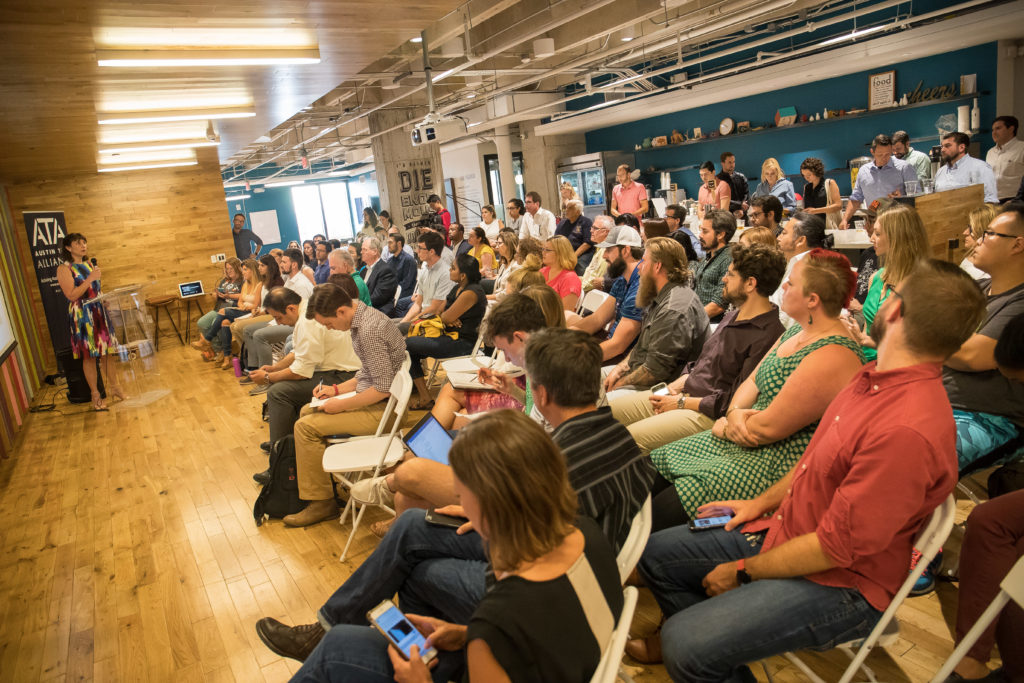Every Austin poll reveals transportation is one of the top concerns for our community, regardless of where in the city you live or what you do.
Technology has a role in helping to address this challenge, so Austin Tech Alliance and General Assembly joined forces to host civic leaders working to combine the world of tech and transportation. At this exclusive keynote and panel event at WeWork Congress, we convened thought leaders from the City of Austin and the transportation industry to explore new intersections between their fields and technology.
We were joined by: Karla Taylor (Chief of Staff, Austin Transportation Department), Chris Nielsen (Founder & CEO, Electric Cab North America), Kathleen Baireuther (Manager, Rocky Mountain Institute), Joseph Kopser(President, Grayline), Joe Deshotel (Former Director of Community Engagement, RideAustin), and Meg Merritt (Principal, Nelson\Nygaard Consulting Associates).
The evening’s conversation was full of technology — from autonomous vehicles to mobility data to the economic and social impacts of automation — but a lot of time also focused on non-tech solutions.
Here are three quick takeaways from the discussion:
#1: Autonomous vehicles are still a ways off — and they’re not a panacea to our transporation woes.
Karla Taylor spoke about the City of Austin’s goal of becoming a leader in the shared, autonomous, electric vehicle future, providing the audience an update on the roadmap — pardon the pun — that City Council asked staff to develop. Just getting to the autonomous part of that trifecta may still take awhile.
The Boston Consulting Group estimates that, by 2025, fully autonomous vehicles will only account for 0.5 percent of auto sales, growing to just under 10 percent by 2035:

The first adopters of AVs will likely be high mileage fleet vehicles moving people and freight, something that Chris Nielsen with Electric Cab is working on. He’s actively trying to combine autonomous vehicle technology with his fleet of electric cabs to aid in microtransit and last mile solutions.
But keep in mind that even when there is a critical mass of AVs on the road, traffic will continue to be a challenge. As Meg Merritt explained, it’s simply an issue of geometry: you can only fit a certain number of cars on a road at any given time. Which is why …
#2: Technology is key, but behavioral change is essential.
Last week, the Downtown Austin Alliance released its downtown Austin parking strategy. The report contained a chart that, more than anything else, explains Austin’s traffic problems:

With almost four in five Austin drivers commuting alone, it suggests the most immediate way to manage congestion during rush hour is a behavioral change. After all, imagine just a 10 percent reduction in that figure and the number of cars it would take off the road during the busiest times of the day.
But the behavioral change that would be required — getting drivers to carpool or use an alternate means of transportation— isn’t easy, espescially in the suburbs of Austin that do not currently benefit from regular, reliable public transportation.
That conversation subsequently raised question posed to the panel: “How do you even get the public to adopt shared-use vehicles in a car culture?”

#3: Transportation pricing will change in the future.
The answer to that question, according to Kathleen Baireuther, partially lies in letting the market more accurately shape transportation pricing. In Joseph Kopser’s words, this would help to reflect the “fully burdened cost of transporation.”
As Kathleen pointed out, we as a society currently subsidize roads and parking, which inevitably leads to skewed economics around driving. As long as it is cheapest in the short term for someone to continue commuting alone in their car, the numbers shown above aren’t likely to budge, and traffic congestion will continue to get worse as more people move to Austin.
This is a conversation that will be continuing in our community over the coming years, so stay tuned for more opportunities to get engaged.

